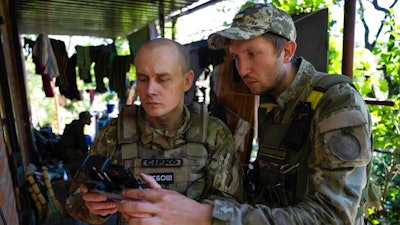
KYIV, Ukraine (AP) — Drone camera footage defines much of the public's view of the war in Ukraine: grenades quietly dropped on unwitting soldiers, eerie flights over silent, bombed-out cities, armor and outposts exploding into fireballs.
Never in the history of warfare have drones been used as intensively as in Ukraine, where they often play an outsized role in who lives and dies. Russians and Ukrainians alike depend heavily on unmanned aerial vehicles to pinpoint enemy positions and guide their hellish artillery strikes.
But after months of fighting, the drone fleets of both sides are depleted, and they are racing to build or buy the kind of jamming-resistant, advanced drones that could offer a decisive edge.
The urgency was reflected by the White House’s disclosure Monday that it has information that Iran will be rushing “up to several hundred” unmanned aerial vehicles to Moscow’s aid. Iranian-supplied drones have effectively penetrated U.S.-supplied Saudi and Emirati air-defense systems in the Middle East.
“The Russian drone force may still be capable, but exhausted. And Russians are looking to capitalize on a proven Iranian track record," said Samuel Bendett, an analyst at the CNA military think tank.
Meanwhile, Ukraine wants the means "to strike at Russian command and control facilities at a significant distance,” Bendett said.
The demand for off-the-shelf consumer models remains intense in Ukraine, as do efforts to modify amateur drones to make them more resistant to jamming. Both sides are crowdfunding to replace battlefield losses.
“The number we need is immense,” a senior Ukrainian official, Yuri Shchygol, told reporters Wednesday, detailing the first results of a new fundraising campaign called “Army of Drones.” He said Ukraine is initially seeking to purchase 200 NATO-grade military drones but requires 10 times more.
Outgunned Ukrainian fighters complain that they simply don’t have the military-grade drones needed to defeat Russian jamming and radio-controlled hijacking. The civilian models most Ukrainians rely on are detected and defeated with relative ease. And it's not uncommon for Russian artillery to rain down on their operators within minutes of a drone being detected.
Compared with the war’s early months, Bendett now sees less evidence of Russian drones getting shot down. “The Ukrainians are on the ropes,” he said.
Adding to the defenders' woes: The Ukrainian hero of the war's early weeks, the Turkish-made Bayraktar TB-2 laser-guided, bomb-dropping drone, has become less effective in the face of denser Russian air and electronic defenses in eastern Ukraine. It was the star of many a patriotic Ukrainian video.
“Russians are in a much better position because they fly long-range drones" designed to evade electronic countermeasures, a Ukrainian air reconnaissance unit leader recently told Associated Press journalists outside Bakhmut near the front lines.
On the ground, Russia's more plentiful electronic warfare units can cut off drone pilots' communications, interrupt live video and drop the vehicle from the sky or, if it has homing technology, force it to retreat.
Hence the need for advanced drones that can survive radio interference and GPS jamming and rely on satellite communications and other technologies for control and navigation.
Ukraine's most urgent need is for drones able to help newly arriving longer-range Western artillery hit distant targets, said Marine Capt.-Lt. Maksym Muzyka, a founder of UA Dynamics, a Ukrainian drone maker.
In mid-June, a top adviser to President Volodymyr Zelenskyy specified in a tweet listing various desired armaments that Ukraine needs 1,000 drones if it is to end the war.
The Russian stock of long-range military drones exceeds Ukraine's, but Kremlin supplies are also diminished. Russian troops also fly a lot of $2,000 off-the-shelf quadcopters — often supplied by soldiers' relatives and volunteers, according to social media posts tracked by drone researcher Faine Greenwood.
A Russian deputy prime minister who oversees Kremlin arms industries lamented in a TV interview last month that prewar drone development was not more robust. Yuri Borisov also said Russia was stepping up manufacture of a wide range of drones “although it can’t be done instantaneously.”
Russia has lost about 50 of its most plentiful model of drone, the Orlan-10, but apparently has dozens or scores more, Bendett said.
A new report from Britain's RUSI think tank puts the current lifespan of a Ukrainian drone at roughly a week. Russian electronic warfare units are “imposing significant limitations on Ukrainian reconnaissance in depth” — and Ukraine desperately needs radar-seeking killer drones that can destroy them.
As it stands, Russian forces are “generally able to bring accurate artillery fire down on (Ukrainian) targets three to five minutes" after a reconnaissance drone has identified them.
The war is unlikely to produce more tales of civilian drone operators like the teen whose off-the-shelf surveillance drone helped the Ukrainian military devastate a Russian armored column moving toward the capital, Kyiv, in the week after the Feb. 24 invasion. Operating those drones on today’s front lines is terribly risky.
A Ukrainian drone operator who goes by the call sign Maverick said his fellow pilots often go deep behind enemy lines. Otherwise their drones lack the range to correct Ukrainian artillery fire. That puts them constantly in the sights of enemy artillery.
The U.S. and other Western allies have shipped hundreds of drones, including an unspecified number of “kamikaze” Switchblade 600s that carry tank-piercing warheads. They can fly at 70 mph and use artificial intelligence to track targets. But their range is limited, and they can only stay aloft about 40 minutes.
Potentially of greater utility for reaching Russian ammunition dumps and command posts are the 121 advanced military drones called Phoenix Ghosts that the U.S. acquired for Ukraine in May.
Their specifications are mostly secret, but they can fly for six hours, destroy armored vehicles and have infrared cameras for night missions, said retired Air Force Lt. Gen. David Deptula, a board member of Aevex Aerospace, the manufacturer.
Other drones similarly suited to reconnaissance and artillery spotting include Ukraine’s homegrown Furia, each of which costs $25,000.
About 70 percent of the roughly 200 Furias that Ukraine purchased after Russia initiated hostilities in 2014 have been downed, said Artem Vyunnyk, CEO of the manufacturer, Athlon Avia. Production is resuming at a new factory, he said, but domestic suppliers alone can’t begin to fill Ukraine’s drone gap.
The Ukrainian military's General Staff did not respond to questions about the unmanned aerial vehicles it seeks from allies. Pentagon spokeswoman Jessica Maxwell also declined to comment on Ukraine’s drone requests.
But Shchygol, the head of Ukraine's state service for special communication, made it clear Wednesday that priorities include “kamikaze” drones and models capable of surviving Russia’s thick electronic warfare curtain.
The first missiles fired at an enemy by a U.S. drone came in 2001 against the Taliban in Afghanistan. Since then, drones have become integral to modern warfare, including in the Syrian civil war and the brief but intense 2020 war between Armenia and Azerbaijan over the disputed Nagorno-Karbakh region.
Their proliferation has spawned an entire industry devoted to countermeasures.
Anti-drone equipment supplied to Ukraine by Western companies include gear that can identify not just a drone’s location but its make and model based on the radio frequencies it uses. It then knows how best to disable the drone.
The ever more complex electromagnetic cat-and-mouse game makes Ukraine the world's latest crucible of military technology innovation.
“Everybody now wants drones, special drones, unjammable and whatsoever,” said Thorsten Chmielus, CEO of the Germany company Aaronia, which has contributed technology to Ukraine.
The rapid advancement leads to his nightmare: “Everybody will have millions of drones that can’t be defeated.”






















